Insect Pests and Solutions
There are thousands of insects in the jungle here, and several of them like to feast on our plants. We’re going to try to catalog as many of them as possible to help our friends and neighbors in the area recognize them and know what to do.
Aphids
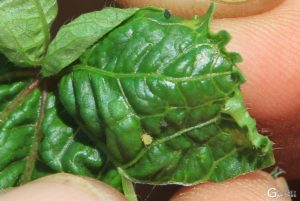 Every gardener and farmer hates aphids. They spread rapidly and take over plants, sucking their juices and stunting their growth. In the photo on the right, you can see that one spinach leaf had three colors of them. Usually we see them as small green bumps around the size of a flea.
Every gardener and farmer hates aphids. They spread rapidly and take over plants, sucking their juices and stunting their growth. In the photo on the right, you can see that one spinach leaf had three colors of them. Usually we see them as small green bumps around the size of a flea.
Solutions:
-
1. Yellow Sticky Traps: See below in “White Flies” for a link to a video of how to make one.
2. Ladybugs. We have a few types of ladybugs here, so look out for them and never kill them. If you know a source for buying ladybugs to release in the garden, let us know. Most countries have this option.
3. Lacewings. Another local bug eats tons of aphids every day. In some countries you can buy them to release on your farm to help you, but we haven’t seen them for sale in Costa Rica (yet). Read here for more about the lacewing: Lacewing
Caterpillar that eats Passionfruit Vine leaves
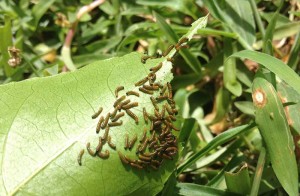 These caterpillars start out tiny and black, from yellow egg groupings, and quickly grow into ravenous monsters. They can devastate your passionfruit vines. Once they grow to full size, they will eventually turn into a gorgeous “Juno” butterfly.
These caterpillars start out tiny and black, from yellow egg groupings, and quickly grow into ravenous monsters. They can devastate your passionfruit vines. Once they grow to full size, they will eventually turn into a gorgeous “Juno” butterfly.
Read much more on this: The passion fruit caterpillar problem
Solution:
Tear off the leaves when you find the egg or family groupings. Leave a few of them on your plants to eat a bit of the leaves, because when passionfruit is stressed, it produces more fruit.
Caterpillar that eats Spinach and Arugula
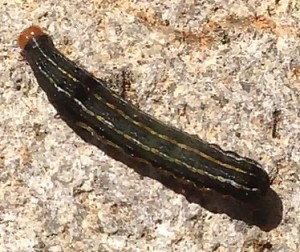 This caterpillar seemed to greatly prefer spinach and arugula, while leaving alone the kale and collard family greens. We were surprised it like arugula so much because ours is very spicy. At times, we have serious infestations of these, and they’re difficult to control. We tried bringing in chickens to eat them, and the birds did give them a few pecks to taste them, but didn’t like the flavor and instead preferred eating grass.
This caterpillar seemed to greatly prefer spinach and arugula, while leaving alone the kale and collard family greens. We were surprised it like arugula so much because ours is very spicy. At times, we have serious infestations of these, and they’re difficult to control. We tried bringing in chickens to eat them, and the birds did give them a few pecks to taste them, but didn’t like the flavor and instead preferred eating grass.
Solutions:
1. Control with native wasps: We are encouraging a small wasp that loves these to live in large numbers near the farm. Click here to see our simple solution and how we do it: Article: Wasp that eats caterpillars
2. We’ve found that we shouldn’t let the spinach grow into huge groups or they’re more easily infested. So now we keep them in smaller bunches and trim them around the edges for our salads, pestos, and stir fries.
Cucumber Beetle
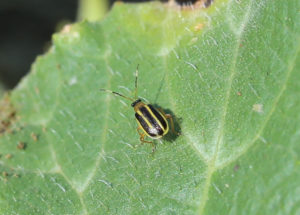 “Acalymma vittatum” is the Latin name for this annoying little Striped Cucumber Beetle, that seems to hop/fly from leaf to leaf and infests many different types of plants, not just cucumbers.
“Acalymma vittatum” is the Latin name for this annoying little Striped Cucumber Beetle, that seems to hop/fly from leaf to leaf and infests many different types of plants, not just cucumbers.
More on this bug here: Striped Cucumber Beetle on Wikipedia They are so fast that they often out-run clouds of spray when we try to get them with neem or garlic/pepper sprays, so you really have to spray carefully.
A single female can lay 1500 eggs, and their lifespan is short – only 4-6 weeks, so these things can rapidly take over if not controlled. Their larvae live in the roots for two weeks and can weaken the plant.
Bacterial Wilt
The worst thing about this beetle isn’t the holes they put in the leaves of your plants but an INCURABLE bacterial wilt they can spread (Erwinia tracheiphila). This disease can affect cucumbers, squash, gourds, and zucchini, but apparently watermelon is immune. You can test for it by checking to see if the plant’s sap has become milky and sticky. Cut the stem near the crown and slowly pulled apart, the sap will make a viscous string if it has the disease.
There’s no cure, but some strains are more susceptible than others to the disease, so save your seeds from the plants that seem to be stronger against it.
Solutions:
We haven’t found a way to eliminate them, but we can keep their numbers down. The usual foliar sprays help. Squashing them by hand, when you can catch them helps of course but is a lot of work. They are slower in morning and evenings so don’t even bother to try during mid-day because they’re too fast. Check the insides of flowers carefully, and it was suggested to use yellow rubber gloves that have the fingers coated with petroleum jelly. Wearing a yellow shirt can attract them to you when they fly off the plant, where you can squash them more easily.
Birds, frogs, and many predatory insects eat them, so if they get into a sealed greenhouse they will multiply like crazy without their enemies around.
Yellow sticky traps are excellent to catch them.
Chickens love to eat them, if you can keep them focused, and they will even eat the larvae in the soil.
Lots of great info is here: http://www.motherearthnews.com/organic-gardening/pest-control/organic-cucumber-beetle-control-zw0z1304zkin.aspx
Leaf Miner / Tomato Leaf Borer
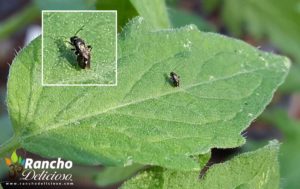 This is a very tiny black fly that we thought was a hopping beetle until we zoomed in the photo and could see it was either a fly or a bee/wasp. They are very fast. When you try to spray them, many clearly can outjump/fly the spray to escape, and we found our usual sprays didn’t control them well.
This is a very tiny black fly that we thought was a hopping beetle until we zoomed in the photo and could see it was either a fly or a bee/wasp. They are very fast. When you try to spray them, many clearly can outjump/fly the spray to escape, and we found our usual sprays didn’t control them well.
This little fly is black with transparent wings, and it lays its larvae on the plant leaves, which bore through it leaving an irregular trail.
Thanks to Ed Bernhardt from The New Dawn Center for helping us to identify it. More about this bug here: Leafminer
Solution: Try your best to spray the adults with organic bug killers and be sure to get the undersides of the leaves.
Jogoto Larvae – Scarab Beetle
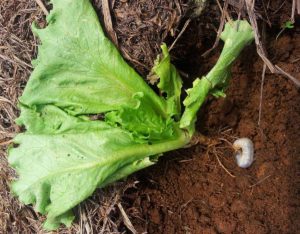 The Jogoto (Jogoto Phyllophaga sp.), as it’s called here, is the larvae of a very pretty metallic gold scarab beetle that come in swarms certain times of the year and are attracted to light bulbs.
The Jogoto (Jogoto Phyllophaga sp.), as it’s called here, is the larvae of a very pretty metallic gold scarab beetle that come in swarms certain times of the year and are attracted to light bulbs.
We found these transparent worms eating the roots of our lettuces. It’s easy to see when a lettuce is being eaten because it starts to wilt, even though its neighbors are fine. We tried digging them out but had to kill the plant to get them.
Solutions:
-
1. Long Fork: One way to get them is to use a long straight fork, like from a BBQ, and stab many times beneath the roots of the lettuce, which will puncture the larvae without totally destroying the lettuce roots.
2. Calcium and Ash Mixture: This website (Spanish) suggests using “Cal y Ceniza” mixed into water: http://www.ruta.org/rediao/node/1783
3. Detailed Study: This article has a detailed study of the lifecycle of this insect, with possible solutions: http://books.google.co.cr/books?id=8cM4jkoaJtYC&pg=PA50
Pickleworm
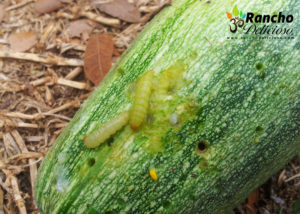 This horrible worm destroys nearly all of our zucchinis and many melons. At night, a moth comes to lay small eggs that hatch and burrow into the roots, flowers, and fruit/vegetables. They start out with small black spots and eventually turn all green. They’re especially hungry for the male zucchini flowers, which can make pollenization difficult.
This horrible worm destroys nearly all of our zucchinis and many melons. At night, a moth comes to lay small eggs that hatch and burrow into the roots, flowers, and fruit/vegetables. They start out with small black spots and eventually turn all green. They’re especially hungry for the male zucchini flowers, which can make pollenization difficult.
Solutions: Not really any so far. We pick off the zucchini flowers as soon as possible before they can bore into the zucchinis themselves. They seem to have few or no natural enemies here. Spraying various organic repellents hasn’t been effective.
More on pickleworms here: http://entnemdept.ufl.edu/creatures/veg/pickleworm.htm
Stinkbugs
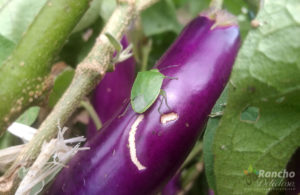 These are about the size of a dime, and come in various colors, which seem to be various stages of growth, not separate species. They fly, and are difficult to kill because they’re very strong and also because they smell so terrible when you squish them. Their life-cycle is a bit over two months, and in the tropics can run through 4 generations each year, easily multiplying to large numbers if left unchecked.
These are about the size of a dime, and come in various colors, which seem to be various stages of growth, not separate species. They fly, and are difficult to kill because they’re very strong and also because they smell so terrible when you squish them. Their life-cycle is a bit over two months, and in the tropics can run through 4 generations each year, easily multiplying to large numbers if left unchecked.
They are especially destructive to our Eggplants and Cucumbers, but are known to attack all types of plants, especially younger plants, young fruits, and stems. They puncture the skin and suck out the juices.
Solutions:
-
Parastic Fly: Besides crushing them by hand, the best possible way to reduce their numbers would be to release the parasitic fly Trichopoda pennipes also known as the tachinid fly. They are native to Costa Rica, and in some countries one can buy them to release for pest control. I haven’t found a place to buy them in Costa Rica.
Parasitic Wasp: These attack the eggs, but I don’t know what type or we could look for them and try to encourage them to live here in greater numbers.
Other Insect Predators: Ladybugs and Lacewings supposedly will eat them, probably when they’re young.
Night Trap: You can build a trap with an LED light and a 2 liter plastic bottle. See this video: https://www.youtube.com/watch?v=78GpAVr_uXI
Decoy Plants: Supposedly they are very fond of Okra, which grows great here, so we could plant more Okra around the gardens and try to catch them.
Damp Towel Trick: I read that you can hang a damp towel near to the plants during the night, and they will be attracted to it, and in the morning, you can put the towel and all the stinkbugs into a plastic bag and leave it in the sun to kill them. We need to test this.
Whiteflies
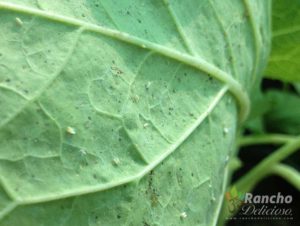 Whiteflies are tiny (flea sized) flies that eat our kale, collards, broccoli etc. They like to land on the underside where it’s difficult to spray them.
Whiteflies are tiny (flea sized) flies that eat our kale, collards, broccoli etc. They like to land on the underside where it’s difficult to spray them.
They don’t destroy the plants, but they weaken them, inhibit growth, and make them less beautiful and not very marketable.
We use the classic “Garlic and Chile” sprays, but it doesn’t work well enough. A few always escape and they multiply quickly.
Solutions:
-
1. Yellow Sticky Trap – These bugs are attracted to the color yellow. So you can smear a non-toxic glue onto yellow plastic and they will stick to it. Here’s a link to a video that shows you how to make one: https://www.youtube.com/watch?v=vONXlePZ23U
2. Ladybugs – Unfortunately no one sells them in Costa Rica that we know of, but sometimes we see them naturally here. Just not enough of them.
3. Easy Homemade Spray – Madera Negro + Oregano leaves, 2 days in water – 3 parts water to 1 part leaves. Add rubbing alcohol as a preservative.














